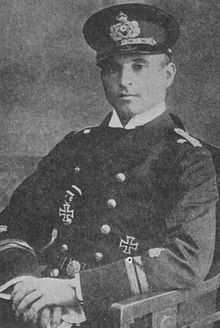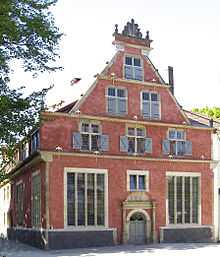Otto Weddigen
| Otto Eduard Weddigen | |
|---|---|
 Otto Eduard Weddigen | |
| Born |
15 September 1882 Herford |
| Died |
18 March 1915 (aged 32) Pentland Firth |
| Allegiance |
|
| Service/branch |
|
| Years of service | 1901 - 1915 |
| Rank | Kapitänleutnant |
| Commands held |
U-9, 1 August 1914 – 11 January 1915 U-29, 16 February 1915 - 18 March 1915 |
| Battles/wars | U-boat Campaign (World War I) |
| Awards |
Pour le Mérite Iron Cross First & Second Class |
Otto Eduard Weddigen (15 September 1882 – 18 March 1915) was a German U-boat commander during World War I.
Biography and career
He was born in Herford, in the Prussian Province of Westphalia and started his military career in the Kaiserliche Marine in 1901. In 1910 he was given command of one of the first German submarines, U-9.
On 22 September 1914, while patrolling in the region of the southern North Sea known to the British as the "Broad Fourteens", U-9 intercepted the three warships of the Seventh Cruiser Squadron. Weddigen fired off all six of his torpedoes, reloaded while submerged, and in less than an hour sank the three British armoured cruisers HMS Aboukir, HMS Hogue and HMS Cressy. Sixty two officers and 1,397 men were killed, only 837 survived. Weddigen was awarded the Iron Cross, second and first class.



After sinking HMS Hawke and some merchant ships, Weddigen received Prussia's highest military order, the Pour le Mérite. He also received the highest military honors of the other kingdoms of the German Empire: The Knight's Cross of the Military Order of Max Joseph of the Bavaria (making him one of only six non-Bavarians to receive this), the Knight's Cross of Saxony's Military Order of St. Henry and the Knight's Cross of Württemberg's Military Merit Order.
Weddigen died while commanding the submarine U-29. On 18 March 1915 U-29 was rammed by the British battleship HMS Dreadnought in the Pentland Firth. U-29 had broken the surface immediately ahead of Dreadnought after firing a torpedo at HMS Neptune and Dreadnought cut the submarine in two after a short chase. There were no survivors from the submarine.
During the inter-war period, the resurgent Wehrmacht named a newly built barracks in Herford as Otto-Weddigen-Kaserne in his honour due to the linkage with his birthplace. Although the Wehrmacht unit housed inside the barracks was not naval - it was Panzer Abwehr Abteilung 6, an Army anti-tank unit - the occupants of the barracks nevertheless signified the naval connection to Weddigen by placing two large anchors at the base of a large National Socialist Reichsadler at the entrance to the barracks. Ironically, ever since 1945 the barracks has been occupied by British Army soldiers from the Royal Corps of Signals. The barracks is scheduled to close with the eventual withdrawal of all remaining British Forces in Germany in 2020.
External links
| Wikimedia Commons has media related to Otto Weddigen. |
|
Bibliography
- Edwards, Bernard (1996). Dönitz and the Wolf Packs – The U-Boats at War. London, UK: Cassell Military Classics. pp. 11–12. ISBN 0-304-35203-9.